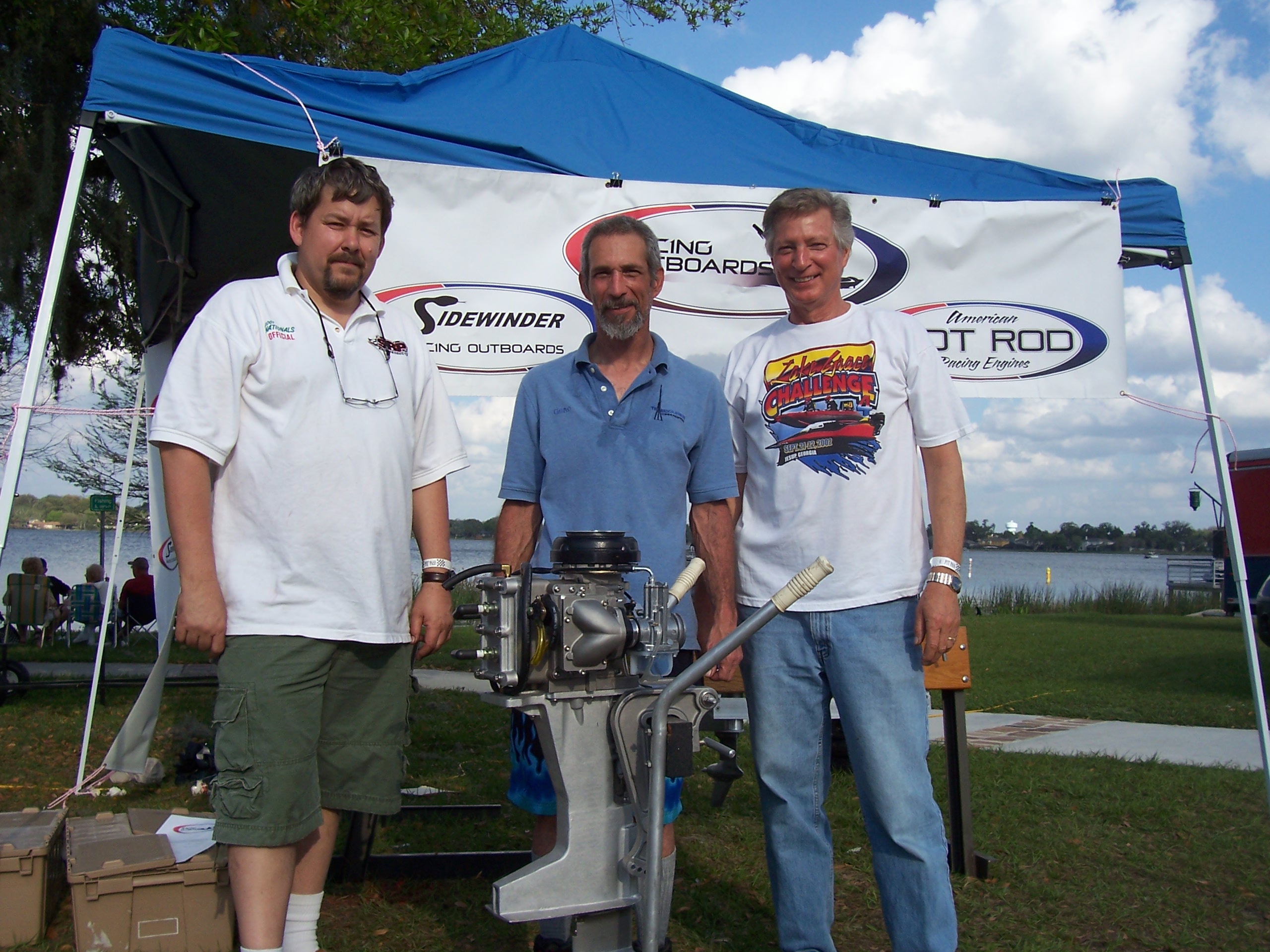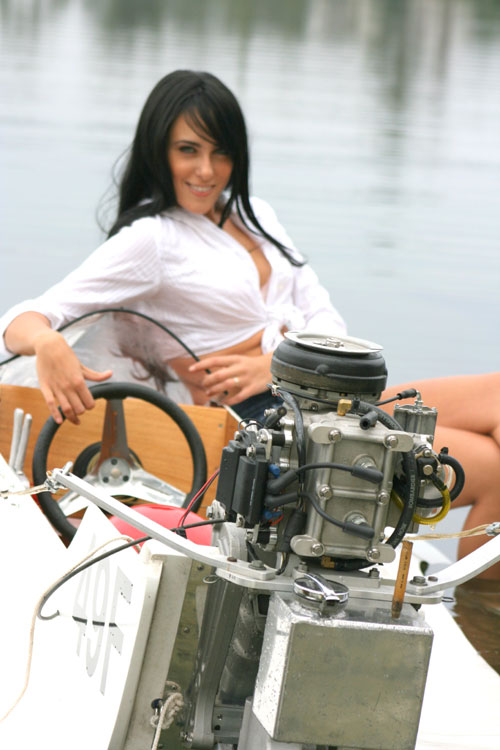
Pictured above (Left to Right) Ed Runne Chief Engineer/Mechanic, Gene Schertz Purchasesr of the first sidewinder, and Ron Selewach Owner.
After growing up poor, struggling and working hard, I had achieved some level of success in business. Not the greedy type of businessman, I soon began looking for ways to “give back.” Having raised my three children by myself, family life and young people – their character development and citizenship – were very important to me.
With a lifelong love of water and boating, around the year 2000 I learned of a nearby race for those “kneel-down boats” I had admired as a kid. I was quite surprised by what I found. The first thing that struck me was that the number of boats and racers was way down from the 1960’s when I first saw them. Not knowing anyone, I just walked around and observed. I saw a young boy sitting at the water’s edge looking disappointed as he threw rocks in the water. Assuming that his equipment had broken down, I asked him why he was unhappy. He told me his parents would not let him race that weekend because he had gotten bad grades in school (that impressed me). Early the next morning, as I walked through the pits I saw whole families camping and cooking breakfast. Every member had a responsibility and chores to do. Boy, those eggs and bacon sure smelled good that crisp morning. I realized I had found what I was looking for – close knit families with real parents and well-mannered kids. Having raised my daughter, as well as my sons, to achieve whatever she set her mind to, it was important to see that Moms and daughters were just as competitive on the race course as the Dad’s and sons were – no sexism in this sport. There were even single Mom’s there, who felt completely safe, and looked after by the rest of the attendees. Everyone helped each other, on and off the race course!
But I learned that weekend that the sport was dying – motors were hard to find and there were no new motors at all. How could the sport grow when it was so hard for a newcomer to get started? After some time, I was able to locate a used rig and began racing, enjoying the camaraderie as much as the competition. I later became aware that the American Hot Rod line was for sale and purchased it. I soon met Dave Little, the last person to actually manufacture the motors, and what a gem he has been. Dave has been an enthusiastic coach and wealth of performance and manufacturing wisdom. I then met Ed Runne, a great engineer and machinist, and refreshingly honest. The engine design had its problems and was very expensive to produce. One of my objectives was to attract young people back to this sport that was such a great example of quality American family values, and I knew the motors had to be as inexpensive as possible. By converting the motor over to a reed valve system, we were able to reduce start-up costs by over $250,000, and shave more than $2,000 off the cost of each motor.
Objectives for the Sidewinder models (a name, incidentally, suggested by racing’s own Ron Whitaker):
1) Rebuild Attendance - My objectives for this project were many, but primarily to help rebuild attendance by providing new equipment. I’m pleased to report that we have already begun to successfully attract some new racers, drawn by the availability of new equipment and ease of maintenance. (Jeff Ruth, NBRA President, also helped with the availability of a great new trailer).
2) Reliable Motors – America today is not the industrial nation it was in the 50’s and 60’s and needing to tinker and constantly maintain motors was a deterrent. The design had to be bulletproof, at least as good as the standard set by the Yamato motors. The Sidewinders have higher quality castings, better modern, computer controlled machining, and beefed-up components. We have run these motors for over 30 hours with no problems and very little wear. No “hand grenades” anymore.
3) Easy to Maintain – To be effective in drawing new people, the motors had to be easy to maintain, and they have been designed with that in mind. They can be raced on the weekend, and parked afterwards with no maintenance like the old days. The powerhead can be completely disassembled with 4 wrenches and 2 screwdrivers. An “engine guru” is not required to maintain these motors. All fasteners are easy to get to.
4) Easy to Operate – The back of the boat does not have to be lifted out of the water to enable the engine to start; the motors start in the water, usually on the first pull. The motors idle to and from the pits without stalling. Weighing only 60 lbs, the ride is one of the best you’ll ever experience; handling is a dream, even for new racers.
5) Easy to Inspect – Due to the accuracy of today’s CNC machining, specifications are very “tight” on these engines. Illegal modifications to stock engines will be easy to detect, thus assuring a fair chance to newcomers, but undoubtedly those who know how to make motors go fast legally will be able to do so with these motors as well. Much of the inspection can be done with a degree wheel on the flywheel, and a complete inspection kit consisting mostly of simple “go-no-go” plugs are available.
6) Minimized long term cost of ownership – The engines have been designed to be easily upgraded to faster classes as the racer progresses in ability. The basic engine is the same for all classes. Only carburetor or sleeve/piston changes are required to upgrade the engine from one class to another. All other components can continue to be used, thus assuring the longevity of the initial investment.
7) Competitive performance, without obsoleting existing equipment – Performance of the engine models is as follows. Please consult your sanctioning body for current and probationary class assignments.
| Engine Model | Performance |
|---|---|
| 15Sxx (15 c.i., standard output) | Compares to OMC 15 ci |
| 15Hxx (15 c.i., high output) | Compares to 15 ci Hot Rod |
| 15Mxx (15 c.i. high output, modified) | Factory modified for Mod classes |
| 20Sxx (20 c.i. standard output) | Compares to Yamato 80 |
| 20Hxx (20 c.i. high output) | Compares to 20 ci Hot Rod |
| 20Mxx (20 c.i. high output, modified) | Factory modified for Mod classes |
8) And finally, All American Made – It wasn’t easy, and took some time, but these engines are 100% American made. Don’t ask me why that is important – patriotism I guess. I have nothing against international parts and service (I do a lot of international business with my other company), but I wanted the motor to be true to its 50+ year heritage. Incidentally, we continue to make replacement parts for the American Hot Rod rotary-valve version.

I also wanted the 100% AMERICAN MADE, ALL THE WAY theme to carry over to our first Miss Sidewinder and we specifically sought out an American Indian (100% American made…) to be our first representative.
To summarize, all objectives have been met and we have already begun attracting new people to the sport. The support of racing’s sanctioning bodies has been great, and much appreciated. And finally, I’d like to recognize Ed Runne and Dave Little, Hank Runne (Ed’s Dad), and suppliers Jesel Engineering (the NASCAR folks headed by Rich Runne) and Tad Olson – Olson Aluminum. Without their expertise, engineering, machining, and technical input this project would not have come to fruition. My other business is very demanding and keeps me from attending many races, but I hope to be able to attend more and more events and meet the wonderful people that make up this sport.
